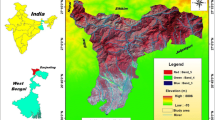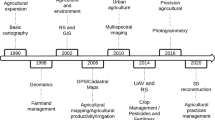Abstract
Two spatial optimization approaches, developed from the opposing perspectives of ecological economics and landscape planning and aimed at the definition of new distributions of farming systems and of land use elements, are compared and integrated into a general framework. The first approach, applied to a small river catchment in southwestern France, uses SWAT (Soil and Water Assessment Tool) and a weighted goal programming model in combination with a geographical information system (GIS) for the determination of optimal farming system patterns, based on selected objective functions to minimize deviations from the goals of reducing nitrogen and maintaining income. The second approach, demonstrated in a suburban landscape near Leipzig, Germany, defines a GIS-based predictive habitat model for the search of unfragmented regions suitable for hare populations (Lepus europaeus), followed by compromise optimization with the aim of planning a new habitat structure distribution for the hare. The multifunctional problem is solved by the integration of the three landscape functions (“production of cereals,” “resistance to soil erosion by water,” and “landscape water retention”). Through the comparison, we propose a framework for the definition of optimal land use patterns based on optimization techniques. The framework includes the main aspects to solve land use distribution problems with the aim of finding the optimal or best land use decisions. It integrates indicators, goals of spatial developments and stakeholders, including weighting, and model tools for the prediction of objective functions and risk assessments. Methodological limits of the uncertainty of data and model outcomes are stressed. The framework clarifies the use of optimization techniques in spatial planning.






Similar content being viewed by others
References
Aerts JCJH, Goodchild MF, Heuvelink GBM (2003) Accounting for spatial uncertainty in optimization with spatial decision support systems. Transactions in GIS 7(2):211–230
Arnold JG, Srinivasan P, Muttiah RS, Williams JR (1998) Large area hydrologic modeling and assessment; part I; model development. Journal of the American Water Resources Association 34(1):73–89
Backhaus R, Bock M, Weiers S (2002) The spatial dimension of landscape sustainability. Environment, Development and Sustainability 4(3):237–251
Bastian O, Schreiber K-F (1994) Analyse und ökologische Bewertung der Landschaft [Analysis and ecological assessment of the landscape]. G. Fischer Verlag, Jena/Stuttgart
Bastian O, Steinhardt U (eds) (2002) Development and perspectives of landscape ecology. Kluwer Academic, Dordrecht
Bayliss JL, Simonite V, Thompson S (2005) The use of probabilistic habitat suitability models for biodiversity action planning. Agriculture, Ecosystems and Environment 108(3):228–250
Benayoun R, de Montgolfier J, Tergny J, Laritchev O (1971) Linear programming with multiple objective functions: step method (STEM). Mathematical Programming 1:366–375
Brandt J, Tress B, Tress G (eds) (2000) Multifunctional landscapes: interdisciplinary approaches to landscape research and management. Conference, Roskilde, Denmark, October 18–21, 2000
Brooke A, Kendrick D, Meeraus A (1992) GAMS: a user’s guide. Release 2.25. Scientific Press. Available at: www.gams.com
Büchs W (2003) Biodiversity and agri-environmental indicators—general scopes and skills with special reference to the habitat level. In: Büchs W (ed) Biotic indicators for biodiversity and sustainable agriculture. Elsevier, Amsterdam, pp 35–78
BUWAL (Bundesamt für Umwelt, Wald und Landschaft) (2002) Feldhase. Schlußbericht 1991–2000. Schriftenreihe Umwelt Nr. 334. Wildtier, Bern
Cairol D, Perret E, Turpin N (2006) Results of the multagri project concerning indicators of multifunctionality and their relevance for SEAMLESS-IF. SEAMLESS report 11:100. Available at: http://www.seamless-ip.org/Reports/Report_11_PD2.3.1.pdf. Accessed September 5, 2007
Caron P, Le Cotty T (2006) A review of the different concepts of multifunctionality and their evolution. European Series on Multifunctionality 10:176
Carter GM, Stolen ED, Breininger DR (2006) A rapid approach to modeling species-habitat relationships. Biological Conservation 127(2):237–244
Chamberlain DE, Gough S, Vickery JA, Firbank LG, Petit S, Pywelland R, Bradbury RB (2004) Rule-based predictive models are not cost-effective alternatives to bird monitoring on farmland. Agriculture, Ecosystems and Environment 101(1):1–8
Chuvieco E (1993) Integration of linear programming and GIS for land-use modelling. International Journal of Geographical Information Systems 7:71–83
Dewess G (1985) Zum spieltheoretischen Kompromiss in der Vektoroptimierung. Optimization 16(1):29–39
Dykstra DP (1984) Mathematical programming for natural resource management. McGraw-Hill, New York
Edwards PJ, Fletcher MR, Berny P (2000) Review of the factors affecting the decline of the European brown hare, Lepus europaeus (Pallas, 1778) and the use of wildlife incident data to evaluate the significance of paraquat. Agriculture, Ecosystems and Environment 79(2–3):95–103
Gass SI (1986) A process for determining priorities and weights for large-scale linear goal programmes. Journal of the Operational Research Society 37:779–785
Gaucherel C, Giboire N, Viaud V, Houet T, Baudry J, Burel F (2006) A domain-specific language for patchy landscape modeling: the Brittany agricultural mosaic as a case study. Ecological Modeling 194(1–3):233–243
Grabaum R (1996) Verfahren der polyfunktionalen Bewertung von Landschaftselementen einer Landschaftseinheit mit anschließender „Multicriteria Optimization“ zur Generierung vielfältiger Landnutzungsoptionen. Shaker-Verlag, Aachen
Grabaum R, Meyer BC (1998) Multicriteria optimization of landscapes using GIS-based functional assessments. Landscape and Urban Planning 43(1–3):21–34
Grabaum R, Meyer T, Gerung J, Wolf T, Friedrich KE, Kildal T, Schreiner V, Meyer BC (2006) The digital user manual for the multi-criteria assessment and optimization method (MULBO). In: Meyer BC (ed) Sustainable land use in intensively used agricultural regions. Alterra Report No. 1338. Landscape Europe, Wageningen, pp 127–132
Haines-Young R, Weber J-L (2006) Land accounts for Europe 1990–2000: towards integrated land and ecosystem accounting. EEA Report No 11/2006:112. European Environment Agency, Copenhagen
Hoffmann J, Greef JM (2003) Mosaic indicators—theoretical approach for the development of indicators for species diversity in agricultural landscapes. Agriculture, Ecosystems and Environment 98(1–3):387–394
Holland JM, Hutchison MAS, Smith B, Aebischer NJ (2006) A review of invertebrates and seed-bearing plants as food for farmland birds in Europe. Annals of Applied Biology 148(1):49–71
Jansen DM, Buijze ST, Boogaardet HL (1999) Ex-ante assessment of costs for reducing nitrate leaching from agriculture-dominated regions. Environmental Modeling and Software 14(6):549–565
Jedicke E (1997) Die roten Listen. Gefährdete Pflanzen, Tiere. Pflanzengesellschaften und Biotoptypen in Bund und Ländern. Verlag Ulmer, Stuttgart
Jessel B (2006) Indicators and assessment of multifunctionality—operationalising the concept for planning applications in landscapes. In: Meyer BC (ed) Sustainable land use in intensively used agricultural regions. Alterra Report No. 1338. Landscape Europe, Wageningen, pp 36–47
Kilgo JC, Gartner DL, Chapman BR, Dunning JB, Franzreb KE, Gauthreaux SA, Greenberg CH, Levey DJ, Miller KV, Pearson SF (2002) A test of an expert-based bird-habitat relationship model in South Carolina. Wildlife Society Bulletin 30(3):783–793
Laaribi A, Chevallier JJ, Martel JM (1996) A spatial decision aid: a multicriterion evaluation approach. Computers, Environmental and Urban Systems 20(6):351–366
Lenton SM, Fa JE, Del Val JP (2000) A simple non-parametric GIS model for predicting species distribution: endemic birds in Bioko Island, West Africa. Biodiversity and Conservation 9(7):869–885
Lewandowski K, Nowakowski JJ (1993) Spatial-distribution of brown hare Lepus europaeus populations in habitats of various types of agriculture. Acta Theriologica 38(4):435–442
Lonergan S, Prudham S (1994) Modeling global change in an integrated framework: a view from the Social Sciences. In: Meyer WB, Turner II BL (eds) Changes in land use and land cover: a global perspective. New York, John Wiley, pp 411–435
Madureira L, Rambonilaza T, Karpinski I (2007) Review of methods and evidence for economic valuation of agricultural non-commodity outputs and suggestions to facilitate its application to broader decisional contexts. Agriculture, Ecosystems and Environment 120(1):5–20
Malczewski J (1999) GIS and multi-criteria decision analysis. Wiley, New York
Malczewski J (2006) GIS-based multicriteria decision analysis: a survey of the literature. International Journal of Geographical Information Science 20(7):703–726
Mander Ü, Mueller F, Wrbka T (eds) (2005) Functional and structural indicators: upscaling and downscaling problems. Ecological Indicators 5(4):267–272
Meyer BC (1997) Landschaftsstrukturen und Regulationsfunktionen in Intensivagrarlandschaften im Raum Leipzig-Halle. Regionalisierte Umweltqualitätsziele-Funktionsbewertungen—multikriterielle Landschaftsoptimierung unter Verwendung von GIS. UFZ-Bericht 24/1997, Leipzig
Meyer BC, Grabaum R (2008) MULBO—model framework for multicriteria landscape assessment and optimization—a support system for spatial land use decision. Landscape Research 33(2):155–179
Meyer BC, Mühle H, Grabaum R (2001) Landschaftsbewertung und -optimierung sowie Entwicklung von Szenarien nach der Methode der multikriteriellen Landschaftsoptimierung. In: Mühle H (ed) Einfluß der Landnutzung auf Landschaftshaushalt und Biodiversität in agrarisch dominierten Räumen. UFZ-Bericht 16/2001, pp 7–30
Meyer BC, Zander P, Karpinski I, Michel B (2005) Multifunctionality of agriculture in Germany. Country Report MultAgri/WP 3. Available at: http://www.multagri.net/section/deliverable/index.php?section=5. Accessed September 3, 2007
Moertberg UM, Balfors B, Knol WC (2007) Landscape ecological assessment: a tool for integrating biodiversity issues in strategic environmental assessment and planning. Journal of Environmental Management 82(4):457–470
Natuhara Y (2006) Landscape evaluation for ecosystem planning. Landscape and Ecological Engineering 2(1):3–11
Neitsch SL, Arnold JG, Kiniry JR, Williams JR (2001) Soil and Water Assessment Tool user’s manual. Version 2000
Noesel H, Ahrens M (1997) Niederwildprojekt Thüringen: Ergebnisse der Felduntersuchungen. Beiträge zur Jagd- und Wildforschung 22:117–125
Nyenhuis H (1999) Distribution and density of the brown hare (Lepus europaeus P.) tested after the influence of land use in North West-Germany. Allgemeine Forst und Jagdzeitung 170(2):28–33
Panek P, Kamieniarz R (1999) Relationships between density of brown hare Lepus europaeus and landscape structure in Poland in the years 1981–1995. Acta Theriologica 44(1):67–75
Petit S, Chamberlain D, Haysom K, Pywell R, Vickery J, Warman L, Allen D, Firbank L (2003) Knowledge-based models for predicting species occurrence in arable conditions. Ecography 26(5):626–640
Rimathe R (1977) Zur saisonalen Abundanzdynamik des Feldhasen (Lepus europaeus Pallas) im Schweizerischen Mittelland. Dissertation. University of Zürich
Romero C (2001) Extended lexicographic goal programming: a unifying approach. Omega 29(1):63–71
Romero C (2004) A general structure of achievement function for a goal programming model. European Journal of Operational Research 153(3):675–686
Rossing WAH, Zander P, Josien E, Groot JCJ, Meyer BC, Knierim A (2007) Integrative modeling approaches for analysis of impact of multifunctional agriculture: a review for France, Germany and The Netherlands. Agriculture, Ecosystems and Environment 120(1):51–57
Skop E, Schou JS (1999) Modeling the effects of agricultural production. An integrated economic and environmental analysis using farm account statistics and GIS. Ecological Economics 29(3):427–442
Smith RK, Jennings NV, Harris S (2005) A quantitative analysis of the abundance and demography of European hares Lepus europaeus in relation to habitat type, intensity of agriculture and climate. Mammal Review 35(1):1–24
Späth V (1989) Untersuchungen zur Populationsökologie des Feldhasen (Lepus europaeus Pallas) in der Oberrheinebene. Institut für Forstzoologie, Freiburger Waldschutz Abhandlungen. Bd. 8
Straßenbauamt Döbeln-Torgau (2002) Verkehrszählung für Bundesstraßen (2000) und Kreisstraßen (2001). Not published
Sutherland WJ et al (2006) The identification of 100 ecological questions of high policy relevance in the UK. Journal of Applied Ecology 43:617–627
Tamiz M, Jones D, Romero C (1998) Goal programming for decision making: an overview of the current state-of-the-art. European Journal of Operational Research 111(3):569–581
Wierzbicki AP (1979) The use of the reference objectives in multiobjective optimization. IIASA wp:79-66
Wiggering H, Dalchow C, Glemnitz M, Helming K, Mueller K, Schultz A, Stachow U, Zander P (2006) Indicators for multifunctional land use—linking socio-economic requirements with landscape potentials. Ecological Indicators 6(1):238–249
Wossink GAA, Osmond DL (2002) Farm economics to support the design of cost-effective Best Management Practice (BMP) programs to improve water quality: nitrogen control in the Neuse River Basin, North Carolina. Journal of Soil and Water Conservation 57(4):213–220
Wright J, Revelle C, Cohon J (1983) A multiobjective integer programming model for the land acquisition problem. Regional Science and Urban Economics 13(1):31–53
Yoon K (1989) The propagation of errors in multiple-attribute decision analysis: a practical approach. Journal of the Operational Research Society 40(7):681–686
Acknowledgments
This paper stemmed from discussions initiated by Ramon Laplana as part of an invited scholar program of Burghard C. Meyer CEMAGREF, Bordeaux, in the winter of 2006/2007. The work was funded by CEMAGREF. Parts of the examples discussed were developed in the Project “Integrative Umsetzung der multikriteriellen Bewertungs- und Optimierungsverfahrens auf der Querfurter Platte” (IUMBO; at UFZ—Environmental Research Centre Leipzig in 2002–2006), funded by Deutsche Bundesstiftung Umwelt. The French example was funded by basic research of CEMAGREF.
Author information
Authors and Affiliations
Corresponding author
Rights and permissions
About this article
Cite this article
Meyer, B.C., Lescot, JM. & Laplana, R. Comparison of Two Spatial Optimization Techniques: A Framework to Solve Multiobjective Land Use Distribution Problems. Environmental Management 43, 264–281 (2009). https://doi.org/10.1007/s00267-008-9225-0
Received:
Revised:
Accepted:
Published:
Issue Date:
DOI: https://doi.org/10.1007/s00267-008-9225-0




